10 Best Marketing Intelligence Tools for GTM Teams on the Market Right Now

10 Best Marketing Intelligence Tools for GTM Teams on the Market Right Now
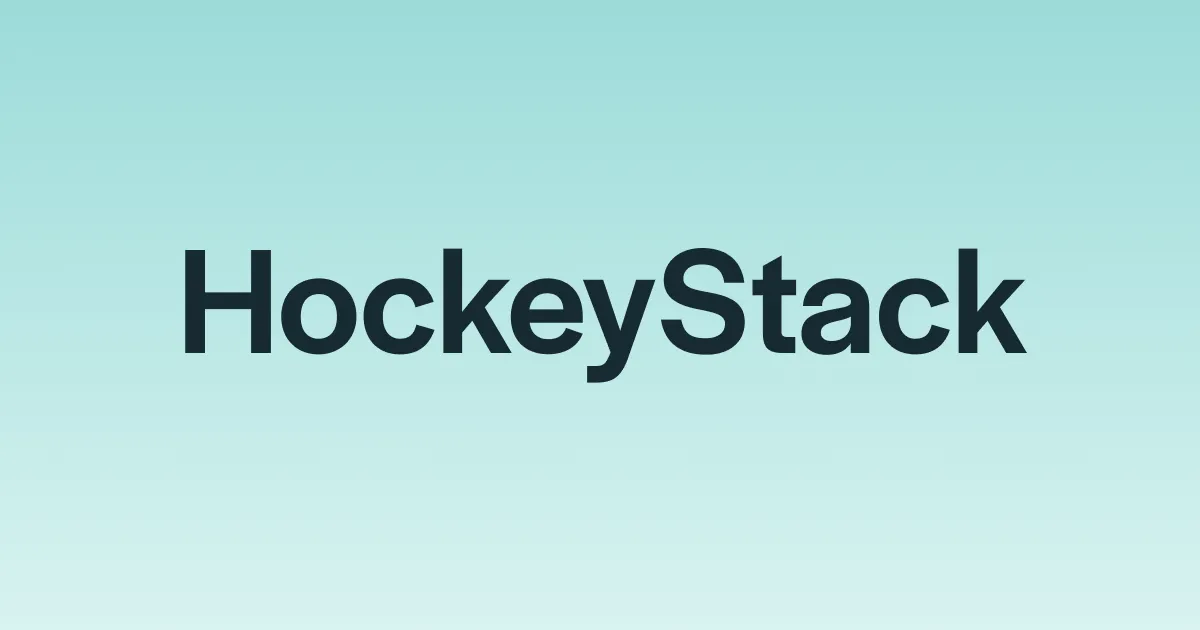
Your GTM team has access to more data than any generation of marketers before you. Customer behavior, intent signals, competitor moves, social listening, attribution reports — it's all there.
Yet, when it's time to decide which campaigns to kill or where to spend next quarter's budget, you still end up relying on your gut.
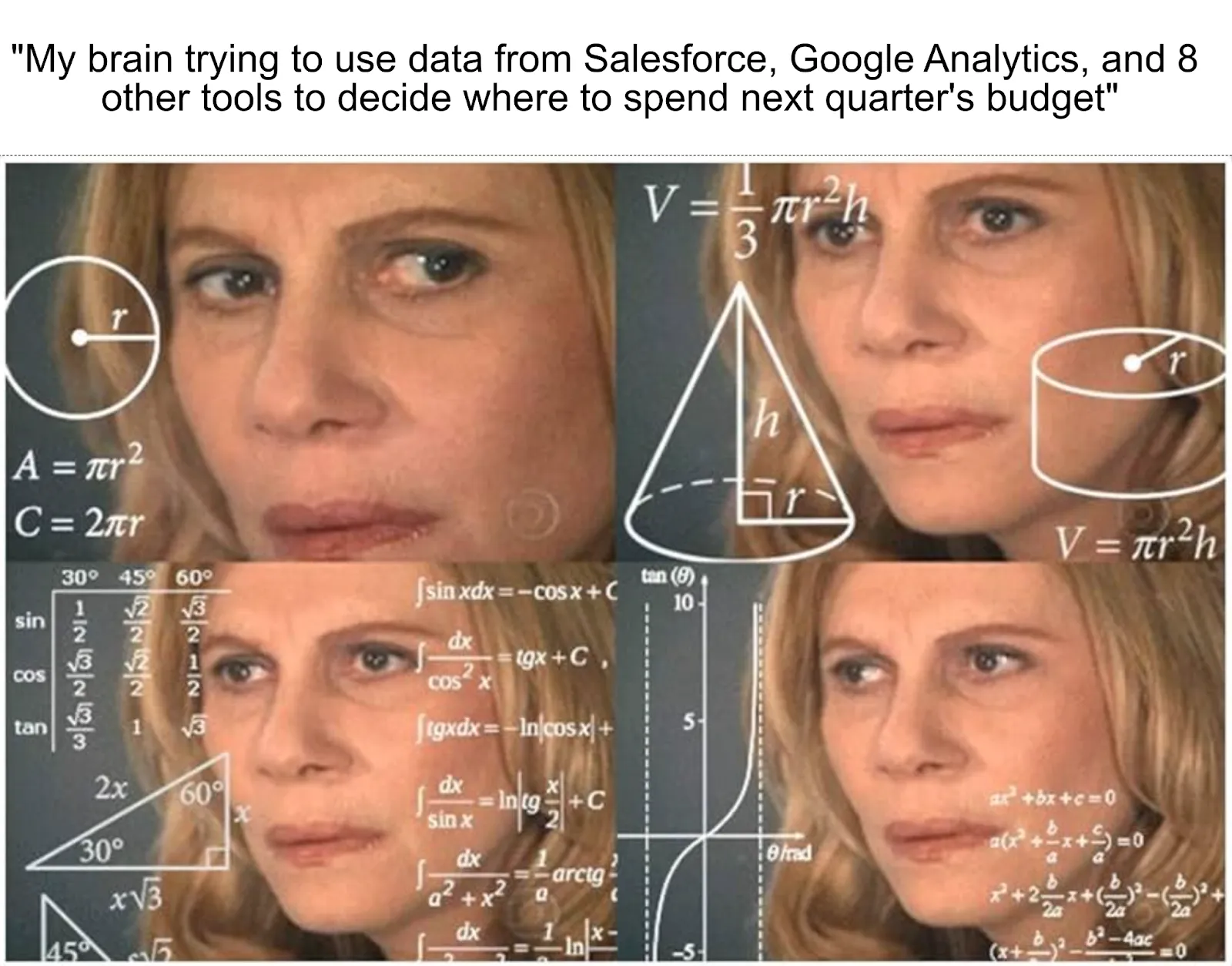
It gets worse. 87% of marketers say data is their company's most underutilized asset. It’s ironic that, despite the fancy dashboards and six-figure tools, so many GTM teams still operate on hunches.
Marketing intelligence tools bridge this gap. They unify and analyze all your internal and external GTM data to give you a complete picture of your market, customers, and performance.
We combed through hundreds of G2 customer reviews, Reddit conversations, and demo videos to outline which tools GTM teams rely on when revenue is at stake.
Below are the 10 marketing intelligence tools that earned our recommendation.
Why It's a Priority Right Now
Marketing intelligence used to be something only big companies with huge budgets could afford. Not anymore. Every GTM team needs it now, and here's why:
- B2B buyers do their homework without you: Today's buyers complete 70% of their journey before talking to sales. They're in private Slack channels, reading peer reviews, and asking their network for recommendations.
- CFOs want receipts for every dollar: The days of getting a budget for "brand building" are over. Every campaign needs clear pipeline attribution. Every hire needs ROI justification. Intelligence platforms give you the proof that your programs drive revenue.
- Your data is scattered across 10+ tools: Customer data in Salesforce, engagement in HubSpot, social metrics in Sprout Social, and random insights in Excel sheets nobody opens. According to Forrester, knowledge workers spend an average of 12 hours a week “chasing data”.
- Competitive landscape changes happen daily: New competitors launch, existing ones pivot, and market leaders change strategies. Marketing intelligence gives you the competitive advantage by tracking competitor activities in real-time, so you can spot opportunities before others do.
- Small signals add up to big insights: A competitor's pricing page gets 3x more website traffic. Five enterprise accounts all research the same feature. Your champion just changed jobs. Individually, these don’t mean much. Together, they're gold. And intelligence tools connect these dots automatically.
What Are Marketing Intelligence Tools?
Marketing intelligence tools are specialized platforms that pull together data from every corner of your GTM stack (CRM, website, ads, socials, competitor tracking, etc.) to provide a single, centralized view of everything that influences your revenue.
These tools have three primary functions:
- They unify your data sources: Your customer data is in your CRM, website analytics are in Google Analytics, ad performance is scattered across platforms, and competitive intelligence sits in spreadsheets. Marketing intelligence tools connect all these sources into one system, so you get a holistic view of your customer journey.
- They use AI/ML to analyze patterns and industry trends: Once they centralize your data, these tools use AI to find market trends that would take your team weeks to discover manually. They'll show you that prospects who download your pricing guide convert 3x more often, or that companies hiring in specific roles make perfect targets for your solution.
- They accelerate strategic decision-making: You don’t have to spend days pulling reports from different platforms to understand what's working. MIT tools show you which marketing campaigns drive pipeline, which content influences deals, and where competitors are outperforming you. You can make informed decisions based on facts.
For example, Google Analytics tells you 500 people visited your pricing page, and that’s pretty much it.
On the other hand, an MI tool tells you that 12 of those visitors work at companies that match your ICP, 3 just received funding, and 1 is actively researching your top competitor — then routes them to your highest-performing sales rep.
Benefits of Using Marketing Intelligence Tools
Used properly, marketing intelligence tools give you a competitive edge and solve problems that cost GTM teams time, money, and deals. To be specific, you can:
- Connect marketing spend to pipeline numbers: Track how that paid search campaign influenced your biggest deals this quarter. Marketing intelligence shows the complete journey, not just last-click attribution that gives all credit to the demo request form. 59% of marketing professionals now use advanced attribution to improve targeting and messaging.
- Make faster GTM business decisions: When a competitor changes their pricing strategies or key accounts start researching alternatives with a similar market position, MI tools alert you immediately. Market research from Google and the Corporate Executive Board shows that 35-50% of B2B deals go to the vendor who responds first — and you can't respond to signals you don't see.
- Get sales and marketing on the same page: When teams share the same data on what campaigns work and can benchmark against goals, the turf wars end. Marketing sends over leads with full context (what they've researched, competitor websites they've evaluated), and sales knows exactly how to approach them. 32% of companies say that the biggest benefit of sales and marketing alignment is increased revenue.
- Spot problems before they escalate: MI tools alert you when market dynamics change, high-value prospects go quiet, or competitors start winning more deals in your space. Poor data quality costs companies up to 25% of their potential revenue, but early detection systems help you tackle these problems when they're manageable.
Key Features to Look for in Marketing Intelligence Solutions
We've seen too many teams buy expensive marketing intelligence tools that nobody uses six months later.
These five features separate the platforms that stick from the ones that become shelfware:
End-to-End Data Integration
Your marketing intelligence tool needs to connect with everything in your GTM stack — your CRM, email platforms, ad accounts, website analytics, social media, and even sales call recordings.
Most teams use 18 different data sources on average, and if your intelligence platform can't pull from all of them, you're still working with an incomplete picture.
💡PRO TIP: HockeyStack connects to 40+ tools through no-code integrations that take minutes to set up. Connect Salesforce, HubSpot, LinkedIn Ads, Google Analytics, and your entire stack without engineering help, and start seeing unified data the same day.
Advanced Attribution & Lift Reporting
Modern marketing intelligence platforms should track every interaction across the entire buyer journey and figure out which touchpoints influenced the deal.
They can tell you that the webinar introduced the problem, the case study built trust, and the competitor comparison sealed the deal. And then, assign appropriate credit to each.
The best tools also measure lift, so you can see the incremental impact of your campaigns. They compare what happened with your campaign versus what would've happened without it.
💡PRO TIP: Switch between attribution models instantly — first-touch, last-touch, linear, or data-driven — to see how credit changes. HockeyStack also runs lift analysis automatically, so you can see the true incremental impact of each campaign without manual calculations.

AI-Powered Insights and Recommendations
AI-powered MI platforms analyze millions of data points to find patterns that would take your team weeks to spot.
They provide automated competitor analysis, where you can see which touchpoints speed up deals, what content drives enterprise sales, and which behaviors happen before customers churn
And you don’t have to pay analysts to crunch numbers all day since the AI handles it and delivers specific recommendations for your market landscape.
For example, it can suggest that you:
- Move 30% of Facebook budget to LinkedIn because it's driving 3x more qualified pipeline
- Prioritize the 47 accounts that downloaded pricing pages in the last week
- Reach out to these 12 companies that just announced Series B funding
- Fix your Google Ads campaign that's burning $5K daily with zero conversions
💡PRO TIP: HockeyStack’s Odin AI continuously learns your specific business context, so recommendations get smarter over time. Ask complex questions like "What's killing our enterprise deal velocity?" and get answers with supporting data in seconds.
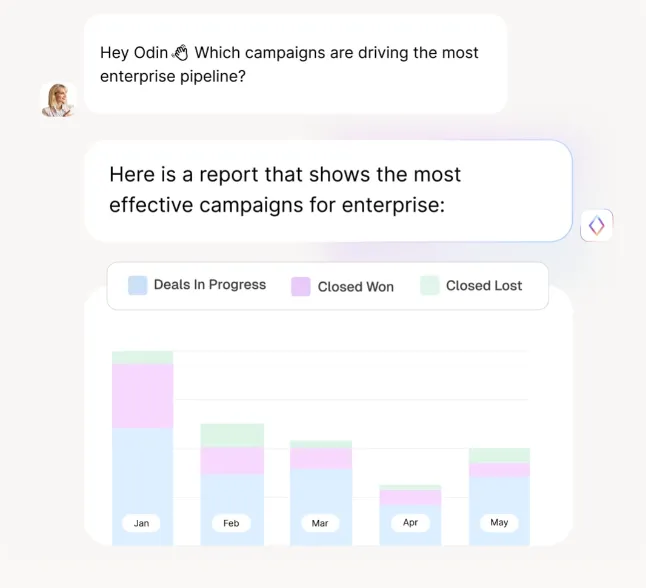
Customizable Dashboards & Natural Language Queries
Modern marketing intelligence platforms let anyone pull actionable insights without knowing SQL or waiting three days for a custom report.
SDRs can check which accounts are heating up, marketers can see what's driving pipeline, and executives can dig into revenue attribution.
Also, look whether there’s a natural language search included. With this feature, you can ask questions like "which blog posts drove enterprise deals last quarter?" and get instant, visual answers.
Cross-Functional Workflows and Alerts
When an account shows buying signals, the platform should alert the assigned rep in Slack, add the account to your ABM campaign, and update the CRM — all without anyone lifting a finger.
This automation layer is what separates reporting tools from revenue tools. Set rules once, and the platform handles the rest.
💡PRO TIP: Nova orchestrates actions across your entire stack simultaneously. When it spots buying signals, it updates Salesforce, alerts sales in Slack, launches LinkedIn ads, and personalizes your website automatically. One signal triggers coordinated action everywhere.
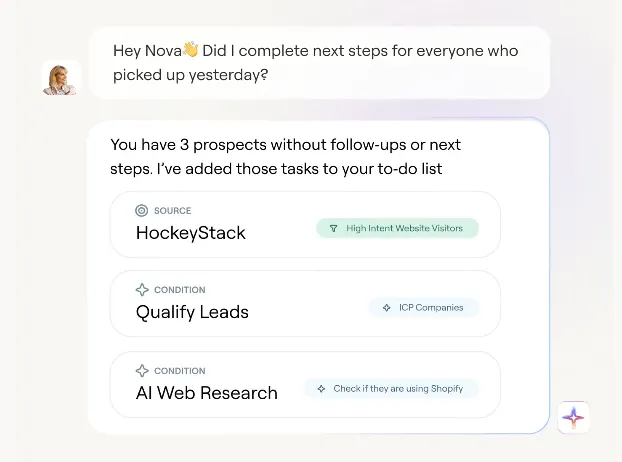
10 Best Marketing Intelligence Tools to Consider
We evaluated dozens of marketing intelligence platforms to understand what's worth your time and budget.
That meant reading hundreds of G2 reviews, combing through Reddit threads where users share their real experiences, and watching demo videos.
We looked for tools that solve real GTM problems, not just generate pretty dashboards.
Each platform on this list excels at something specific, whether that's attribution, ABM, or workflow automation. And we've been honest about where they fall short.
Here's what made the cut:
1. HockeyStack

Best for: B2B GTM teams that want to unify their entire revenue engine with AI-powered intelligence and workflow automation in a single platform.
HockeyStack is a GTM AI platform that connects your entire tech stack to create a unified command center for revenue teams.
The platform pulls data from every touchpoint across the customer journey and uses AI agents (Odin and Nova) to automatically outline pipeline problems and coordinate responses across teams.
Key features
- Odin AI Analyst answers your revenue questions instantly: Ask Odin anything about your funnel, campaigns, or attribution in plain English — it gives you answers with visuals right away. It spots patterns in your data and tells you exactly what to do next, so you're not waiting days for analysis.
- Nova AI for automated GTM workflows: Nova detects high-intent prospects, updates your CRM, and launches personalized outreach sequences automatically. It orchestrates workflows across your entire tech stack so sales and marketing work from the same playbook.
- Multi-touch revenue attribution that proves ROI: See the complete picture of how prospects interact with your marketing before converting, not just first or last touch. Compare different attribution models side-by-side and track both online and offline interactions to make better budget decisions.
- Cross-team coordination without the chaos: The platform connects HubSpot, Salesforce, LinkedIn, and your other tools so everyone works from the same data. Automated GTM workflows handle the coordination that usually requires endless Slack messages and spreadsheet updates.
- Custom reporting built for your GTM motion: Build reports that match how your business actually works with filters by product, geo, channel, and customer personas. Choose from multiple attribution models, create lift reports, and use pre-built templates or customize everything to your needs.
What do G2 users like about HockeyStack
“HockeyStack helped us answer the age-old question, "What is marketing's performance?". The measurement and reporting tool allowed us to successfully analyze the entire buyer journey and evaluate our impact on pipeline and revenue. Our team can now, with confidence, report on attribution with clean dashboards that my CMO frequently takes into his executive meetings.
After we configured the measurement and reporting, we then adopted the Account Intelligence tool, which has opened up a whole new world of opportunities for my team. We now operate within much more intelligent workflows that, with the help of the HockeyStack AI scoring model, elevate the right companies to our sales team with leads that are engaged, aware, and in a buying cycle. It has allowed us to transcend chasing form fills and focus on what matters.” - HockeyStack Review, Andrew N.
What real-world companies say about HockeyStack
Delve is an AI-native compliance platform that helps companies achieve and maintain compliance with minimal manual work. But their digital marketing team faced challenges that most B2B companies know too well:
- Calculating ROI manually across scattered tools (spreadsheets, ad platforms, and email reports)
- Wasting days each month to match marketing spend with actual results
- Had no real-time market insights into customer preferences or what drove booked demos
With HockeyStack, Delve finally upgraded its GTM operations. Some specific results include:
- Cut reporting time by 50+ hours quarterly with automated dashboards
- Got instant answers to revenue questions using Odin AI during live meetings
- Connected every marketing dollar to pipeline impact with unified attribution
- Made faster data-driven decisions based on real performance data and sentiment analysis
Here's what Selin Kocalar, Delve's Co-Founder & COO, shared about their experience:
"Someone in a meeting asked about our total marketing spend. I asked Odin and got the answer immediately—that's when the value really clicked.”
2. HubSpot Marketing Hub
Best for: Small to mid-sized GTM teams already using HubSpot CRM who want unified reporting without switching platforms.
HubSpot Marketing Hub is the marketing automation component of HubSpot's all-in-one platform.
And while it's best known for email campaigns and lead nurturing, it also offers solid attribution reporting and customer journey analytics.
Key features
- Multi-touch revenue attribution: Shows how every interaction contributes to closed revenue, with different models (first-touch, last-touch, linear) to match your reporting needs. Though, you need a Professional tier or above for advanced attribution.
- Customer journey analytics: Visualizes the complete path prospects take from first visit to closed deal. You can analyze conversion rates and time between touchpoints to outline any issues.
- Automated lead scoring and alerts: Uses behavioral data management to find sales-ready accounts and triggers workflows when prospects show buying signals (e.g., visiting pricing pages multiple times).
What do G2 users like about HubSpot Marketing Hub
“The best part about this marketing platform is how seamlessly everything connects—no extra integrations or coding needed. Just buy and start using it right away. Designing emails, forms, and landing pages is incredibly easy with a no-code interface. Visual workflows, lead scoring, and segmentation are powerful and intuitive.
It empowers marketing teams to launch campaigns and automations independently, without relying on developers. I use HubSpot almost every day—whether it's reviewing marketing funnels, sending out emails, or checking a customer’s account history to resolve issues quickly.”
What do G2 users dislike about HubSpot Marketing Hub
“It is literally a product without support. Aside from the ridiculous SLA of 48 to 72 hours via email (no chat, no phone), the support reps are useless. They do not know the product or what it is used for whatsoever. Other than that, reporting is awful. It's been awful on the enterprise version, and Marketing Pro+ is worse.”
- G2 Review, Adir B.
Pricing
Here’s a breakdown of HubSpot’s pricing for the marketing hub:
- Free tools available with basic reporting.
- Starter at $9/month per seat includes limited features.
- Professional at $800/month includes multi-touch attribution and advanced reporting (there’s an annual commitment plus $3,000 onboarding fee).
- Enterprise starts at $3,600/month with full journey analytics.
All paid plans charge based on marketing contacts, which can increase costs as your database grows.
3. Google Analytics 4
Best for: Teams looking for free website analytics and basic attribution tracking, but who understand its limitations in tracking complete B2B customer journeys.
Google Analytics 4 is the world's most widely used web analytics platform, and it tracks user behavior across both websites and apps.
It captures top-of-funnel interactions like page views and form submissions, but can't track offline interactions or connect to CRM revenue data. For most teams, it's a starting point rather than a complete marketing intelligence solution.
Key features
- Event-based tracking model: Treats everything as an event (pageviews, clicks, form fills), so you can flexibly measure user interactions. But B2B teams often hit roadblocks since they can't identify visitors or link them to accounts.
- Cross-device and platform tracking: Follows users across websites and mobile apps to map the digital journey. Just note that it can't track offline touchpoints like sales calls and demos that usually dominate B2B cycles.
- Predictive AI metrics: Includes purchase probability and churn likelihood scores. However, these primarily target ecommerce and need heavy customization for B2B lead scoring.
What do G2 users like about Google Analytics 4
“Google Analytics is such a handy tool for understanding customer needs and how people interact with your website. The detailed reports, real-time tracking, and customizable dashboards make it super easy to make smarter marketing decisions. I especially love how you can set up goals and track conversions to see how user actions connect to business results. Plus, the integration with Google Ads and Search Console is seamless, so you get everything you need in one place.”
- G2 Review, Anna-Kristina R.
What do G2 users dislike about Google Analytics 4
“It requires a lot of setup and manual work to get what you really need. The UI is hideous, and we run into problems often with GA not tracking things correctly. It has pretty substantial limitations for ecommerce tracking and often isn't close to accurate for conversion rate, number of orders, or revenue.”
-Google Analytics Review
Pricing
Free version handles up to 10 million events per month, which is more than enough for most small to mid-sized businesses.
Google Analytics 360 (enterprise) starts at $50,000/year for 25 million events per month. Costs scale based on data volume and can often reach $150,000+ annually.
4. Dreamdata
Best for: B2B SaaS companies with complex, multi-stakeholder sales cycles that need in-depth account-based attribution and customer journey mapping.
Dreamdata is a B2B activation and attribution platform that specializes in mapping the complete account-based customer journey from anonymous first touch to closed-won deal.
The platform takes an account-based approach that outlines all stakeholder interactions across months-long B2B sales cycles.
Key features
- AI-driven attribution modeling: You get 10+ attribution models out of the box plus custom options. Their data-driven model uses Markov chains to dynamically determine which touchpoints drive pipeline progression.
- Audience activation hub: Build precise audiences with all your GTM data and sync them directly to ad platforms daily. The hub also feeds accurate pipeline data back to streamline optimization.
- Interactive customer journey timelines: Visualize every touch at the account level with all stakeholders mapped out. You can see their individual paths plus both known and anonymous interactions, including LinkedIn and G2 engagement.
What do G2 users like about Dreamdata
“We can finally see a holistic view of our accounts and map that against our outreach marketing efforts. It helps us tell the story of a prospect's journey, and we can see what's working. The ability to also get alerts delivered straight into our Teams chats and have Dreamdata connected via their new Google Chrome extension has also helped us improve our response times - we can see leads researching our solutions pages before they even request the demo, so we are better prepared.”
- G2 Review, Kayleigh R.
What do G2 users dislike about Dreamdata
“While the platform is incredibly powerful, onboarding assistance could be more robust. There’s definitely a learning curve when it comes to building custom reports that truly matter without getting distracted by vanity metrics. It can feel a bit overwhelming at first. Like many tools, some of the best features require an upgrade, which pushes it beyond our budget. I also wish there were more real-time data for the sales team, such as notifying a sales rep when a previously stale prospect re-engages.”
- G2 Review, Jill Z.
Pricing
Free plan available with basic B2B analytics and up to 5 seats. Activation plan starts from $750/month with 25 seats and 10,000 MTUs included.
Advanced plans offer custom pricing with AI-based attribution, larger data volumes, and up to 30-day free trials available. Custom pricing.
5. Mixpanel
Best for: Mid-market to enterprise B2B SaaS companies ($10M-$100M ARR) with product-led growth motions that need to connect user behavior to revenue metrics.
Mixpanel is a product analytics platform that bridges the gap between user behavior and revenue impact.
While it’s primarily known for event-based tracking and funnel analysis, Mixpanel has expanded to marketing analytics tools like multi-touch attribution and revenue tracking through warehouse connectors.
Key features
- Revenue analytics with warehouse connectors: Integrates with your data warehouse (Snowflake, BigQuery, Databricks, etc.) to pull in revenue data. You can measure ARR, LTV, and ROAS directly alongside product development metrics.
- Multi-touch attribution modeling: Tracks first-touch, last-touch, and everything in between using UTM parameters and referral data. However, it's limited to digital touchpoints and misses offline interactions.
- Self-serve analytics without SQL: Non-technical teams can explore marketing data through intuitive dashboards and AI-powered insights.
What do G2 users like about Mixpanel
“Mixpanel gives me a crystal-clear view of user behavior across all my products. The event-based tracking system is intuitive, and the flexibility with custom properties is unmatched. Funnels, retention, and cohort analysis are incredibly easy to set up.
The ability to slice and dice data in real time is a massive productivity boost, and the UX is one of the best in analytics tools I’ve used. I also love how easy it is to integrate Mixpanel into new projects and share deep insights with non-technical stakeholders.”
- G2 Review, Alex K.
What do G2 users dislike about Mixpanel
“There is no phone support at all, and only email support is available. Imagine you have a critical business issue related to the tool that needs immediate attention, you will have to wait for 24-48 hours before you get a response.
Now, instead of this platform being supportive to help you succeed in marketing, it’s counterproductive. It’s costing in losing money on potential buyers that we can't touch because of any support from the platform itself.”
Pricing
Here’s a quick pricing breakdown for Mixpanel:
- Free plan includes up to 1M monthly events and 10K session replays.
- Growth plan starts at $0 for 1M monthly events, then $0.28 per 1K events after that (up to 20M events), with 20K monthly session replays included.
- Enterprise plan offers unlimited events with custom pricing.
Startups founded less than 5 years ago with under $8M funding get their first year free.
6. Looker (Google Cloud)
Best for: Enterprise companies with dedicated data engineering teams that need to build custom BI solutions and have the technical resources to manage complex data modeling.
Looker is Google Cloud's enterprise business intelligence platform that uses a proprietary modeling language (LookML) to create a semantic layer for data analysis.
It provides an enterprise platform for BI, data applications, and embedded analytics that helps explore and share scalable insights in real-time.
Key features
- LookML semantic modeling layer: Define KPIs like "monthly active users" in a shared, governed layer. This becomes your single source of truth, so metrics stay consistent across all dashboards and users.
- Enterprise-grade embedded analytics: Robust API coverage that lets you integrate fully interactive dashboards into applications and create custom data experiences.
- AI-powered analysis with Gemini integration: Includes an AI assistant that helps with analytical workflows like visualization creation, formula creation, data modeling, and report creation.
What do G2 users like about Looker (Google Cloud)
“Looker’s biggest strength is its flexibility and powerful modeling layer (LookML), which makes it easy to build consistent, reusable data models. It’s excellent for scaling analytics across multiple teams without reinventing the wheel for every dashboard.
The UI is clean, and the way it handles exploration encourages self-serve data exploration for business users, which is a big win for teams that want to move away from static reports.”
- G2 Review, Mihir M.
What do G2 users dislike about Looker (Google Cloud)
“Despite being a powerful BI tool, Looker's initial setup, particularly when it comes to understanding LookML, can be quite difficult for novices or non-technical users. Workarounds are occasionally needed to customize complicated visualizations, and improper optimization can cause performance slowdown when searching huge datasets. Additionally, the default visualization types are not as varied as some other tools.”
- G2 Review, Shreya P.
Pricing
There are three platform editions with custom pricing through sales:
- Standard for small teams under 50 users
- Enterprise with stronger security features and a wide range of internal BI use cases
- Embed for external analytics and custom apps at scale
7. Segment (Twilio)
Best for: Mid-market to enterprise B2B organizations with technical teams that want to aggregate and route customer data across their tech stack but need separate tools for analysis and activation.
Segment is Twilio's customer data platform (CDP) that collects and routes customer data to downstream tools. It builds unified customer profiles from data across engagement channels and connects to 450+ apps.
It’s powerful for data collection and routing, but you'll need other tools for the analysis and activation that dedicated GTM intelligence platforms provide natively.
Key features
- Real-time data routing to 450+ integrations: Sends unified customer profiles to marketing, analytics, sales, and support tools. However, it doesn't connect these touchpoints to revenue outcomes.
- Reverse ETL and warehouse connectivity: You can connect historical data with real-time insights across your business. Customers sync nearly 10 trillion rows of data to cloud data warehouses like Snowflake and BigQuery.
- Predictive AI capabilities with CustomerAI: Machine learning predicts future behaviors like churn risk and purchase intent.
What do G2 users like about Segment
“The best part about Twilio Segment is its ability to centralize customer data from multiple sources and then route that data in real time to tools like analytics platforms, CRMs, and marketing automation software. It saves a huge amount of engineering time and ensures data consistency across platforms.”
- G2 Review, Sachin D.
What do G2 users dislike about Segment
“Hypersegmentation is complicated and not necessarily possible. Difficult to pinpoint issues when integrating with other tools.”
Pricing
There are two main product lines:
- Connections plans (Free, Team, and Business) for basic data collection and routing from 700+ apps
- Customer data platform (CDP) plans (Unify and Engage) for advanced unified profiles and real-time personalization.
Connections offers a free plan, while CDP plans start with custom pricing and include enterprise features like predictive AI and advanced audience orchestration.
8. Salesforce Marketing Cloud
Best for: Large enterprise B2B companies that are already heavily invested in the Salesforce ecosystem and need an all-in-one marketing suite.
Salesforce Marketing Cloud is an enterprise marketing automation platform that combines email marketing, customer journeys, and analytics within the broader Salesforce ecosystem.
The platform includes Data Cloud, Engagement, Personalization, and Marketing Intelligence solutions sold as individual products that make up the entire portfolio.
Key features
- AI-powered campaign orchestration with Einstein: Provides predictive analytics using machine-learning algorithms that monitor historical data to forecast customer behaviors and optimize marketing programs.
- Marketing cloud intelligence: Unifies data from 170+ connectors, including major advertising, commerce, CRM, and database vendors. It also comes with automated reporting and cross-channel performance analysis.
- Journey Builder for multi-channel automation creates custom marketing workflows with triggers and responses across email, SMS, social, and web channels throughout the customer lifecycle.
What do G2 users like about Salesforce Marketing Cloud
“The biggest win is its ability to unify fragmented data across platforms—Google Ads, Meta, CRM, SEO tools, email, and more—into one clean, customizable dashboard. The automated reporting saves hours each week, and the insights have genuinely helped optimize campaign performance. It’s also great for aligning teams with a single source of truth.”
- G2 Review, Kruti K.
What do G2 users dislike about Salesforce Marketing Cloud
“Working with this software requires specialised knowledge and skills. It can be quite challenging and time-consuming to master on your own, so an experienced professional may be needed to ensure it runs smoothly.”
- G2 Review, Karthik G.
Pricing
Salesforce Marketing Cloud offers a few pricing plans:
- Starter Suite at $25/month per user for basic CRM with marketing, sales, and service
- Marketing Cloud Growth Edition starts at $1,500/month per organization (billed annually)
- Advanced Edition at $3,250/month per organization
Additional products include Data Cloud from $108,000/year, Marketing Engagement from $2,500/month, and Marketing Intelligence from $3,000/month, with custom enterprise pricing available.
9. 6sense
Best for: Enterprise B2B companies with complex sales cycles that need AI-powered account intelligence and intent data to find and reach anonymous buying committees.
6sense is a revenue AI platform that tracks anonymous buying signals across the web to spot in-market accounts before they contact your sales team.
The platform analyzes over a trillion daily signals from its Signalverse data network, so revenue teams can predict which accounts will buy and run personalized campaigns at scale.
Key features
- AI-powered account detection and scoring: 6sense's AI sees, scores, and ranks every signal with predictive models that spot accounts with buying intent (even before they fill out a form).
- Intelligent Workflows engine: From one drag-and-drop canvas, the Intelligent Workflows engine takes AI signals and automates plays across ads, email, web, and sales channels.
- Conversational email and AI agents: The platform includes AI email agents that write personalized emails for each prospect, automate responses based on context, and can even book meetings for reps.
What do G2 users like about 6sense
“I really like the new 6sense Workflows capabilities. We’re currently using it to pilot a pipeline acceleration campaign, and it gives us the ability to get very granular with ad timing, including when ads should be served and for how long. It also allows us to layer in perspective filter data, which adds another level of precision.”
- G2 Review, Rachael K.
What do G2 users dislike about 6sense
“We were extremely dissatisfied with support, had difficulty proving ROI from the platform, and had a few negative experiences with various teams within the organization, from product to finance to customer support. We found the orchestrations product very difficult to use and the data in their database often incorrect and out of date.”
Pricing
6sense offers a free plan with 50 data credits per month, basic company search, sales alerts, and list-building tools.
Paid tiers include "Sales Intelligence + Data Credits" (adds intent data, technographics, and persona mapping) and "Sales Intelligence + Predictive AI" (adds AI recommendations, account summaries, and advanced workflows).
Learn more → 6sense vs. Demandbase: 2025 Comparison (+ Better Options)
10. Demandbase
Best for: Mid-market to enterprise B2B companies that want a centralized ABM platform that connects account identification, targeted advertising, and sales intelligence in one system.
Demandbase is an account-based GTM platform that helps B2B teams spot and target high-value accounts with AI-powered insights and intent data.
The platform centralizes first-party and third-party data to orchestrate personalized campaigns across advertising, sales, and marketing channels.
Key features
- Native B2B advertising platform: Demandbase’s proprietary ad solution that can reach entire buying teams across multiple channels. It uses account intelligence for precise targeting and optimizes campaigns in real-time.
- Cross-channel orchestration: The platform coordinates campaigns across email, ads, web personalization, and sales outreach from a single interface. It creates dynamic audiences based on behavior and syncs them to platforms like LinkedIn, Salesforce, and your marketing automation tools.
- Website personalization at the account level: Dynamically tailors your website content for each account that visits. It shows them relevant case studies and CTAs based on their industry, buying stage, and past interactions.
What do G2 users like about Demandbase
“Demandbase One is instrumental in our go-to-market strategy, specifically when it comes to our customer lifecycle. The platform allows us to use data and valuable insights we would otherwise not have to better orchestrate and personalize our approach, leverage what works, focus our intentions, adapt and optimize the work we do and the money we spend.”
- G2 Review, Britt K.
What do G2 users dislike about Demandbase
“There is a bit of a learning curve with Demandbase due to the volume of options available to you. Also, a bit of a downside is that it is an account tool, so it's harder to see individual activity.”
- G2 Review, Greg L.
Pricing
Demandbase uses custom enterprise pricing with no published rates. You'll need to contact sales for a quote.
Why HockeyStack is the Modern Choice for GTM Intelligence
Look at what you're dealing with right now:
- BI platforms that are powerful for data visualization, but need dedicated analysts and weeks to build reports
- ABM platforms that are great for account targeting, but cost six figures and take months to implement
- Web analytics tools that track everything about your site, but can't connect any of it to revenue
- Point solutions for attribution, intent data, and AI workflows that each solve one problem but don't connect
These tools work great in isolation. But you can't wait three days for your BI team to pull a report, then cross-reference it with your ABM platform, then manually update your CRM. By the time you act, the opportunity is gone.
HockeyStack takes a different approach. One platform that brings all your data together, provides deep AI-powered intelligence, and automates the repetitive tasks that eat up your team's time.
Here's what that looks like in practice:
A True GTM Command Center
Most tools are built for either marketing or sales. Marketing gets its attribution dashboard, sales gets its account intelligence, and RevOps spends half its time trying to reconcile the differences.
Meanwhile, everyone's looking at different numbers and arguing about what's working.
HockeyStack, on the other hand, plugs into your entire GTM stack through simple, no-code connections that take hours to set up.
We clean up and centralize all that messy data so you can finally see what happens from first touch to closed deal. One platform, one source of truth, and everyone working from the same playbook.
An AI Team at Your Fingertips
Odin AI answers your hardest revenue questions in plain English. Ask about funnel trends, campaign performance, or attribution for any time period, and you'll get answers with visuals instantly.
It writes reports, explains what's happening in your data, and recommends exactly what to do next based on patterns it spots. No more waiting days for custom analysis or piecing together stories from multiple dashboards.
Nova AI runs your outbound engine on autopilot. It watches for buying signals, gathers intel on promising accounts, enriches your CRM, and launches targeted campaigns. Your entire tech stack finally operates as one coordinated system.
An Engine for Action
Knowing what's happening is only half the battle. You still need to act on it. And most tools show you that enterprise accounts are engaging, but leave you to manually update Salesforce, brief your sales team, and launch your campaigns.
HockeyStack closes that gap. When Odin spots intent signals, Nova jumps into action:
- Enriches the account with company size and tech stack
- Outlines the decision-makers on LinkedIn
- Updates your CRM with a hot lead score for strategic planning
- Notifies the account owner in Slack with talking points
- Launches a personalized email sequence
All this happens in minutes, not the days it takes to coordinate between teams manually.
So, if you're still exporting CSVs to answer basic revenue questions, manually updating your CRM after every campaign, or arguing about attribution in weekly meetings — there's a better way.
HockeyStack was built for teams that want to graduate from spreadsheet chaos to real revenue intelligence. Take our interactive demo to see the difference.
FAQs
What's the difference between marketing intelligence and market intelligence software?
Market intelligence software monitors what's happening outside your company — your competitors, your industry, the general market. It pulls in external data to help you spot opportunities and track what rivals are up to. You'd use it to answer questions like "Is our competitor gaining market share?" or "What new players just entered our space?"
Marketing intelligence software is the command center for your entire GTM motion. It connects all your tools (from CRM and ads to emails and sales calls) to show you the complete journey from first touch to closed deal.
These platforms rely on artificial intelligence to find patterns you'd never spot manually, like which combination of touchpoints leads to enterprise deals or why certain campaigns drive 10x more pipeline.
What's the real difference between a marketing intelligence platform and a BI tool like Looker?
BI tools like Looker are blank canvases — incredibly powerful, but you need data engineers to connect your sources, analysts to build dashboards, and weeks to get anything useful.
Marketing intelligence platforms are built specifically for GTM teams. They come with pre-built connections to your CRM, ad platforms, and marketing tools.
You can use them for revenue attribution, buyer journey analysis, and launching automatic workflows. With the right tool, you’ll see value in days, and you don’t need a technical team to maintain it.
Do I need to hire a data analyst to use one of these platforms?
Not for modern tools. The old generation of BI platforms required a PhD in SQL just to pull a basic report. Today's platforms are built for actual GTM teams, not data scientists.
Take HockeyStack's Odin AI, for example. You can literally type "Show me which campaigns influenced our biggest deals last quarter" and get an answer with visuals in seconds.
No SQL, no waiting for the data team, no complex query building. Most platforms now offer drag-and-drop report builders, pre-built templates, and natural language search that anyone on your team can use.
That said, some enterprise platforms still lean technical. If you're looking at something like Looker or even certain features in Salesforce Marketing Cloud, yeah, you'll probably need dedicated resources. But if you choose a platform built for marketers and sales teams, your existing team can handle it just fine.
How quickly can I expect to see ROI from a marketing intelligence tool?
The quick wins come in weeks. You'll stop wasting hours on manual reports and immediately spot money bleeding from underperforming campaigns. Most teams find major wasted spend in their first week just by seeing their real cost per opportunity across channels.
The second wave builds over your first quarter. The AI learns your specific business patterns and starts providing insights you couldn't find before. For example, which touchpoint combinations influence enterprise deals, which accounts are warming up, and where deals typically get stuck.
Can these tools track offline activities like events or direct mail?
Yes, good platforms handle offline touchpoints too. While they primarily connect to digital channels automatically, you can import data from trade shows, conferences, direct mail campaigns, and sales calls to get the complete picture.
Most platforms let you upload CSV files with event attendee lists or use simple forms to log offline interactions.
The better ones, like HockeyStack, can even connect these offline touches to your attribution models, so you'll finally know if that $50K conference booth truly influenced any deals.
Introducing Odin in Slack: Your AI Analyst, Right Where You Work
Get instant answers on pipeline, campaigns, and GTM gaps. Just tag @hockeystackodin and go from question to action—right where you work.


Ready to see HockeyStack in action?
HockeyStack turns all of your online and offline GTM data into visual buyer journeys and dashboards, AI-powered recommendations, and the industry’s best-performing account and lead scoring.
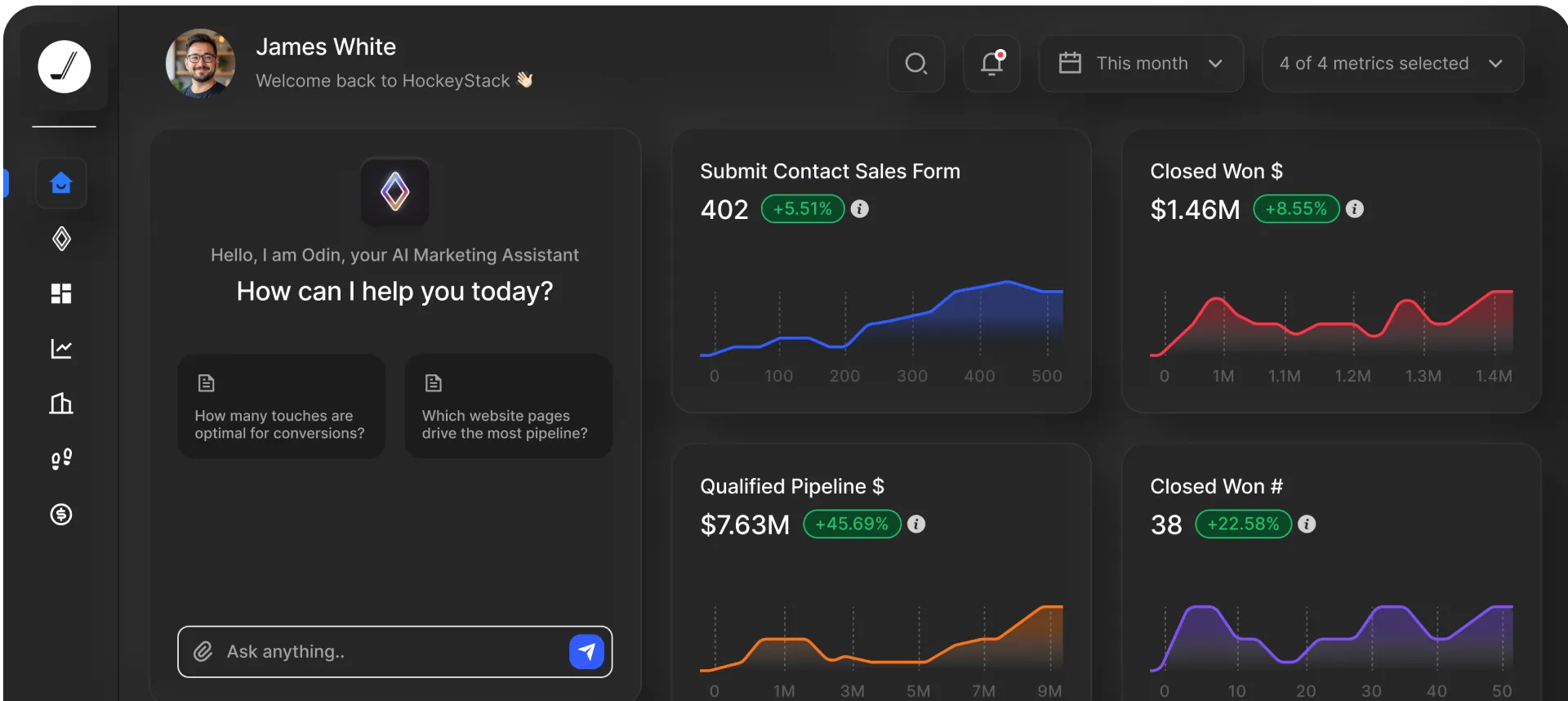
Ready to See HockeyStack in Action?
HockeyStack turns all of your online and offline GTM data into visual buyer journeys and dashboards, AI-powered recommendations, and the industry’s best-performing account and lead scoring.




